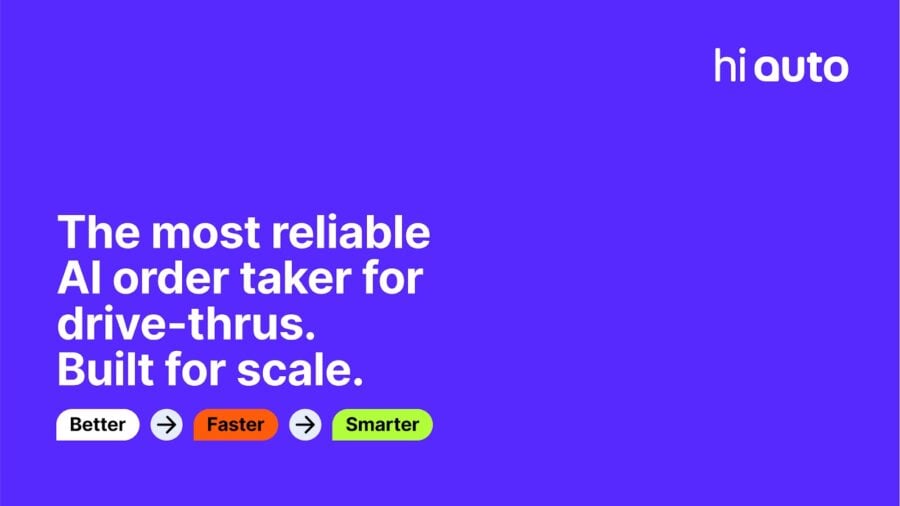For decades, the drive-thru has been both a revenue engine and a pain point for quick-service restaurants (QSRs). Margins depend on volume, but bottlenecks in the lane are stubbornly resistant to quick fixes. When major chains like McDonald’s and Taco Bell began experimenting with fully automated AI order taking, many in the industry saw it as the breakthrough that would finally solve the problem. Instead, high-profile rollouts faltered, plagued by errors and customer frustration.
Hi Auto believes the issue was a combination of technology and strategy. This week, the company unveiled a new brand identity and website to match its growth to nearly 1,000 locations worldwide. But behind the design refresh lies a bigger bet: that trust and relatability are the missing pieces to making AI work in the fast food industry.
When Speed Isn’t Enough
Hi Auto’s metrics are impressive: its AI order taker completes over 93% of orders and delivers 96% accuracy. Yet CEO and Co-founder Roy Baharav insists that those figures, while essential, aren’t the whole story.
“While our AI Order Taker consistently achieves 93%+ order completion and 96% accuracy across nearly 1,000 stores, we’ve always believed adoption depends on more than performance,” Baharav said. “Trust, friendliness, and ease-of-use are just as essential.”
In other words, an AI can shave seconds off an order, but if staff or customers feel alienated, the system risks rejection. That’s what doomed earlier attempts by big chains: a disconnect between technology and the human experience.
A Brand Built for Adoption
According to Hi Auto’s Chief Marketing Officer, Maya Dror Melamed, the rebrand wasn’t about modernizing aesthetics. It was about tackling the adoption barrier directly.
“This wasn’t an aesthetic touch-up; it was about aligning our brand identity with our business and product strategy,” she said. “We began with a deep positioning effort to define the core of who we are, what we do best, and why it matters. That strategy shaped a brand and website that speak with clarity, purpose, and warmth, built to earn trust and drive adoption.”
That clarity matters in an industry that has traditionally been slow to adopt new technologies. By positioning itself as accurate and approachable, Hi Auto is speaking to operators who’ve seen automation projects burn cash without delivering lasting value. The urgency of the situation is clear, and Hi Auto’s solution is more necessary than ever.
Personifying the Machine

The centerpiece of the rebrand is “Auto,” a character meant to embody Hi Auto’s technology. Auto listens carefully, speaks clearly, and never forgets. Alongside Auto are a cast of characters inspired by everyday quick-service realities: Joe, Jim, Barbara, Willy, and the Winnies.
To some, mascots seem like a whimsical flourish. But in Baharav’s view, they signal a deeper point. “Auto represents the soul of our solution,” he said. “With the rest of the crew, we’re showing that our AI isn’t just reliable, it’s also intelligent, relatable, and surprisingly fun.”
By giving its AI a visible identity, Hi Auto is pushing back against the perception of automation as cold or faceless. It aims for restaurant owners and their employees to view its solution as “the best crew member on the shift.”
The Competitive Landscape
The timing of Hi Auto’s push is critical. The QSR industry continues to wrestle with staffing shortages, rising wages, and tightening margins. According to the National Restaurant Association, 62% of operators say they still don’t have enough workers to meet demand. At the same time, digital ordering and delivery have shifted customer expectations toward convenience and speed.
That creates a paradox: chains need to serve more customers with fewer people, but automation attempts risk alienating both staff and diners. Hi Auto’s wager is that a friendlier, more trustworthy AI can bridge that gap.
Beyond the Lane
If the strategy is successful, the implications extend beyond drive-thrus. Friendly, reliable AI could take root in kiosks, delivery integrations, and even customer service touchpoints. By branding its product as a teammate, Hi Auto is positioning itself to expand wherever QSRs face the same equation of high volume, thin margins, and stretched staff.
The company’s rebrand signifies that AI in restaurants won’t succeed on speed alone. It has to win hearts as well as wallets. If Hi Auto is right, the next time you pull up to a drive-thru, the most memorable part of your meal may not be the food but the voice that took your order.

